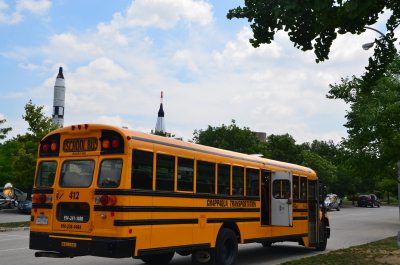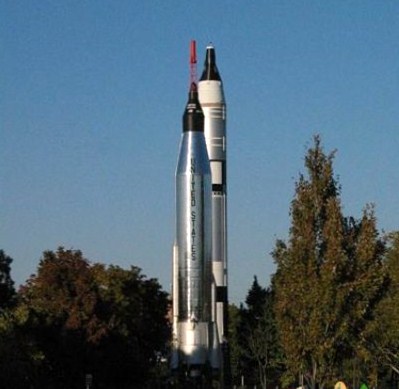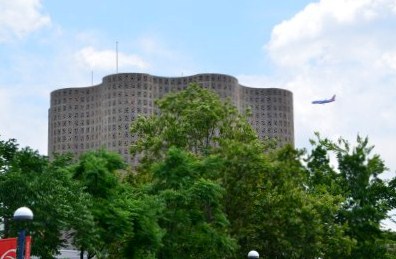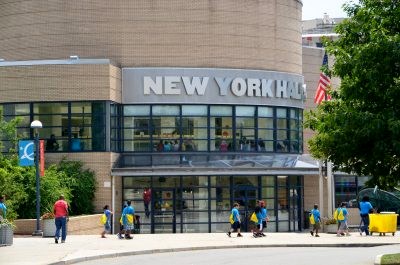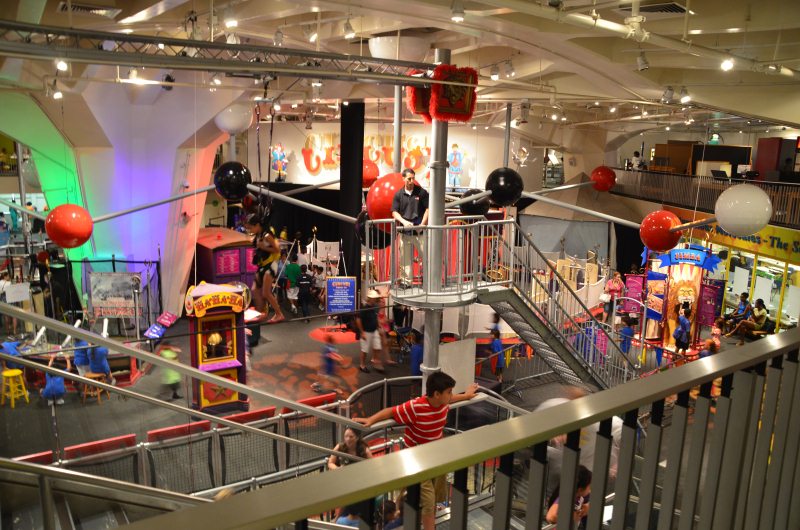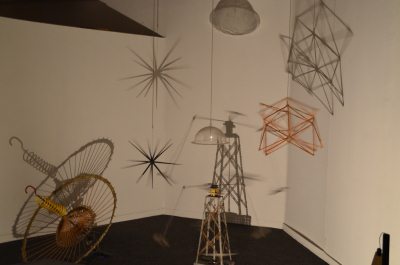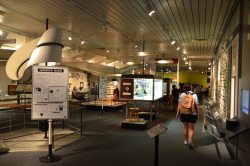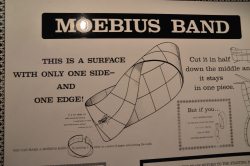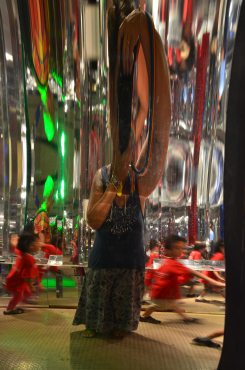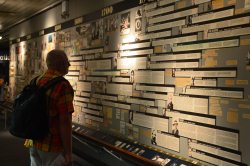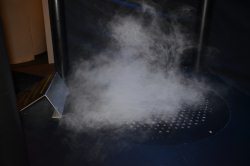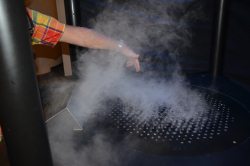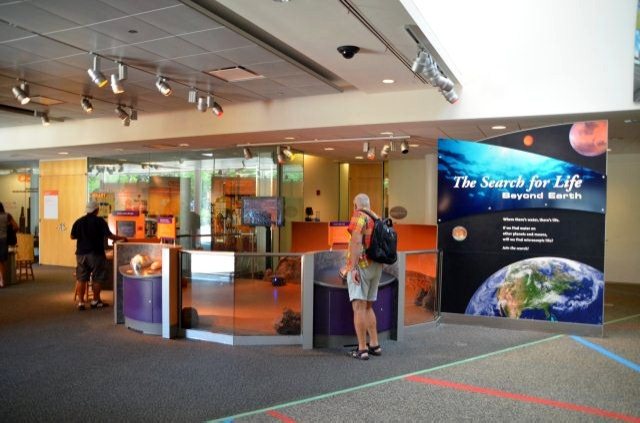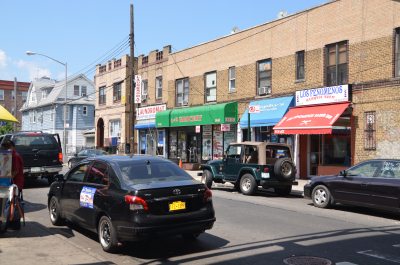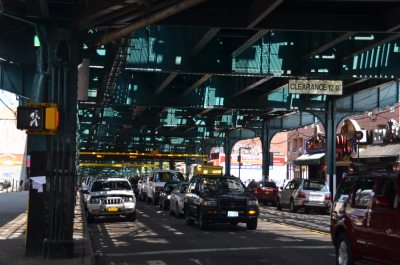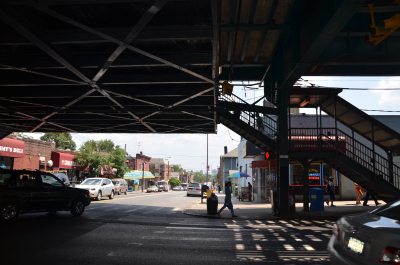NY Hall of Science

|
The New York Hall of Science
Bear chose to visit the New York Hall of Science, off we went on the subway to Queens, nearly as far as Flushing Meadow. For several stops we left the underground and at one point it seemed we were quite high up with very different views over Harlem. We passed a massive subway storage yard with hundreds of parked trains.
We got off the train, walked a few blocks and space shuttles came into view. Bears excitement rose, however, the many school buses verses the few parked cars should have set alarms off. The New York Hall of Science occupies one of the few remaining structures of the 1964 New York World's Fair in Flushing Meadow-Corona Park in the borough of Queens. Today, it stands as New York City's only hands-on science and technology centre.
More alarms should have gone off when the ladies at the tills looked very bemused as we handed over our NY Passes. We left the quite atrium and headed for the main hall - it was set out like a circus - or was that zoo - the noise of hundreds of excited kids was awesome, but we were here and we pressed on. We were the only adult visitors that were alone, that is, not attached to a school party or staff..........
There are more than 400 hands-on exhibits explore biology, chemistry, physics and undaunted, we got stuck in. We watched a little one as she tried out the high wire, complete with balance pole and safety harness. We got into a simulator and the man looking after it with raised eyebrows, as he closed the doors was heard to say in a bemused voice "It's really for kids". I could have told him that as we eased into 'very snug' seats, side handles pressing into flesh. History: The museum was established in 1964 as part of the World's
Fair in Flushing
Meadows-Corona Park and at the time was one of only a few science
museums in existence. Unlike many other institutions, which were closed
immediately or soon after the Fair, the Hall remained open after the fair, and
served as a resource for students. Its exhibits at the time were somewhat
limited but included plans for the world's first atomarium
open to the public. The Hall remained open until 1979, when it closed for major
renovations. New York City hired physicist
Alan Friedman in 1984 to help with the museum's transition and he
oversaw the change from a focus on science
fiction to relevance in the lives of everyday lives. After it
re-opened in 1986 giving New York
City a science
museum for the first time since it had closed seven years earlier,
plans for the display of an atom were realized with a $40,000 exhibit for a quantum
atom that was a part of a $400,000 expansion and renovation at the
museum. The museum's growth and ability to draw crowds was unexpected and led to
the city's pursuit of further funds and expansion. At the time of its re-opening, the museum was unique in that it also
provided a training program for science majors who could then go on to study
under a tuition waiver program at nearby Queens
College in exchange for committing to spend at least two years in
city schools who needed science educators. Its role in the life of city school
children continued, and in 1991 it announced plans for a ten-year, $80 million
renovation and expansion to be able to meet the needs of a growing visitorship.
Further expansion, which included a new entrance, dining area and a science
playground began in 1996 and reflected the need for constant updates in science
museums to keep their displays up to date and relevant. In recognition of its
continued upgrading, the Hall was granted the status of a New York City cultural
institution, given to a limited number of organizations.
In 1999 the decision was made to continue to grow and expand the museum without benefit of an IMAX, since it was determined the market was already saturated. Instead, funds were spent on doubling its exhibition space and restoring its famous rockets, which were donated by the Space program for the World’s Fair and returned in 2003. Also in 2003, the Hall announced "Tech City" its $300m proposal for a science centre as one of the cultural institutions located at Ground Zero. Although "Tech City" made the short list of fifteen finalists in February 2004, during a process that was criticized for a lack of openness and transparency, but was not ultimately chosen. It continues to look for a satellite location in Manhattan while it thrives in Queens.
Funding: In 2005, it was among 406 New York City arts and social service institutions to receive part of a $20 million grant from the Carnegie Corporation, which was made possible through a donation by New York City mayor Michael Bloomberg. The Hall has continued to receive funding from a number of sources essential to its operation and expansion. This represented a welcome change for the museum from the 1990's during which severe cuts in funding threatened its ability to operate successfully.
Exhibits: The Hall mainly focuses on education for children ages 1–17 and its audience consists primarily of city children for whom the exposure to science is something new. The museum includes a large permanent collection as well as a range of travelling exhibitions. Although somewhat more common now, the museum was among the first to have its young visitors assess its exhibits and it welcomed their feedback in preparation for the re-opening in 1986.
I actually enjoyed the side-show tent that held lots of pictures and fun facts about bearded women and sword-swallowers. Bear got his weight done in molecules, millions of them and did his best to be interested in touching a piece of Mars. He had come here to be mentally challenged with mathematics but had to make do with a tuna wrap and a bottle of Diet Coke when we stopped for lunch. Ambling back to the subway felt like we were walking through the film set of The French Connection.
ALL IN ALL BRILLIANT IF WE WERE TEN YEARS OLD AND WITH OUR
CLASSMATES |


